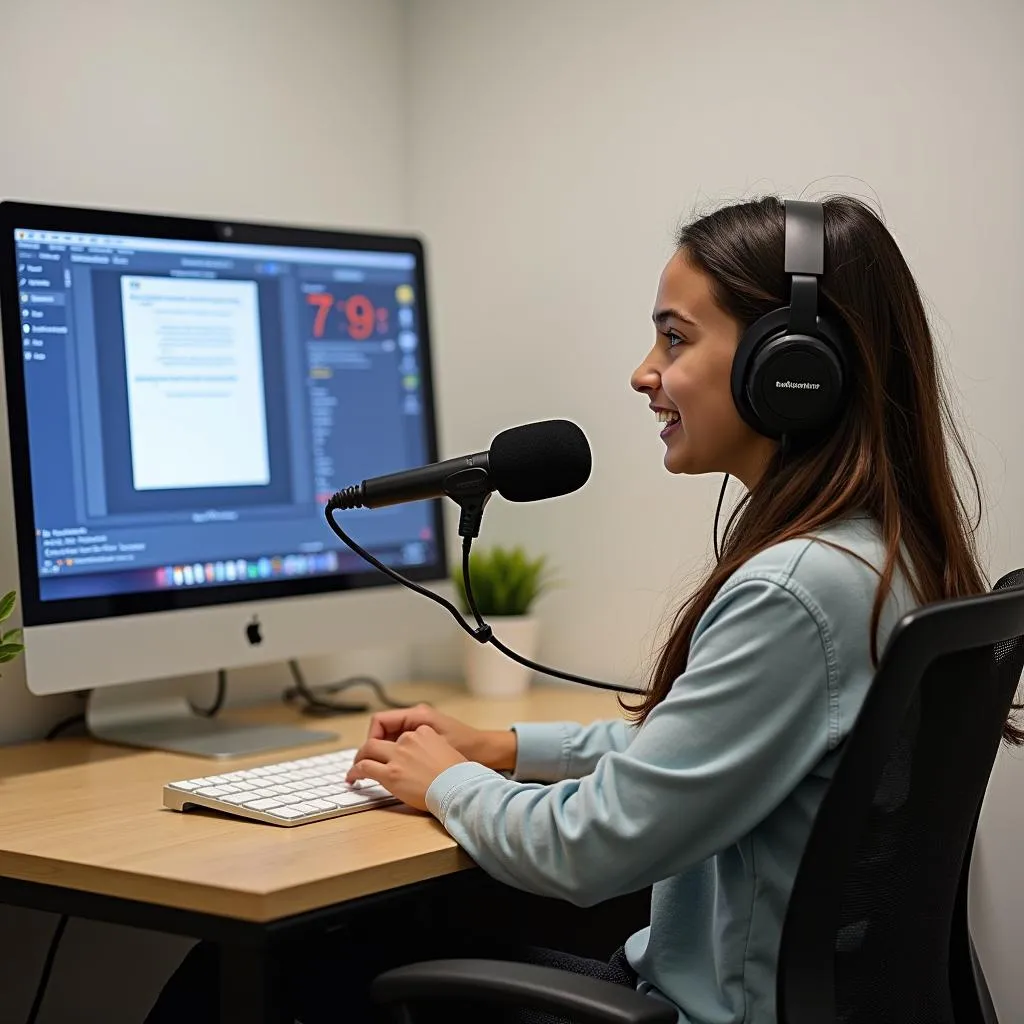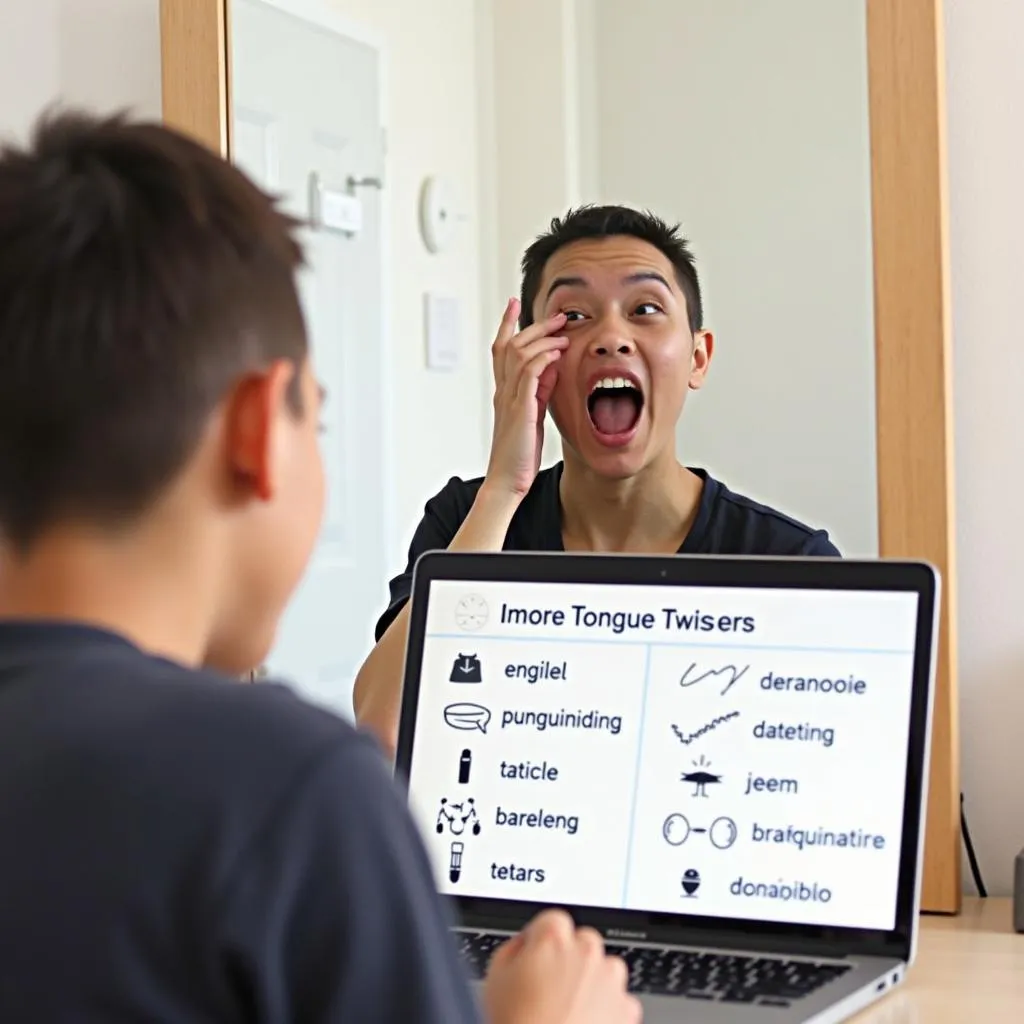Are you preparing for the PTE Academic and looking to boost your speaking skills? Practicing in exam-like conditions is crucial for success. This guide will walk you through effective strategies to simulate the PTE speaking environment, helping you build confidence and improve your performance.
Understanding the Importance of Realistic Practice
Realistic practice is the cornerstone of PTE success. By mimicking exam conditions, you’ll:
- Reduce test-day anxiety
- Familiarize yourself with time constraints
- Improve your ability to think and speak quickly
- Enhance your overall performance
Dr. Emma Roberts, a renowned PTE expert, emphasizes, “The more you practice in exam-like conditions, the more comfortable and confident you’ll feel on test day.”
 Student practicing PTE speaking in a simulated exam environment
Student practicing PTE speaking in a simulated exam environment
Creating an Exam-Like Environment at Home
To practice effectively, recreate the PTE testing environment as closely as possible:
- Find a quiet, distraction-free space
- Use a computer with a reliable internet connection
- Invest in a good-quality headset with a microphone
- Set up a timer to track your responses
- Use official PTE practice materials or PTE speaking practice apps for authentic questions
Remember, consistency is key. Aim to practice in this setup regularly to build familiarity and comfort.
Mastering Time Management
Time pressure is a significant factor in the PTE speaking section. To improve your timing:
- Use a stopwatch for each task
- Practice answering within the allocated time limits
- Record yourself to analyze where you can improve speed and efficiency
“Effective time management can make or break your PTE score,” notes Dr. Roberts. “Regular timed practice is essential for developing this crucial skill.”
For more detailed strategies on managing your time effectively during the exam, check out our guide on PTE exam time management practice.
Enhancing Fluency and Pronunciation
Fluency and pronunciation are vital components of the PTE speaking section. To improve:
- Record your responses and listen back critically
- Focus on maintaining a steady pace without long pauses
- Practice difficult sounds and word combinations
- Use tongue twisters to improve articulation
 Student using pronunciation techniques for PTE speaking
Student using pronunciation techniques for PTE speaking
Integrating these practices into your routine will help you build fluency for the PTE speaking section more effectively.
Utilizing PTE-Specific Practice Materials
To truly simulate exam conditions, use materials that mirror the actual test:
- Official PTE practice tests
- PTE preparation books with audio components
- Online PTE simulators with speaking modules
- YouTube videos featuring real PTE speaking tasks
Dr. Roberts advises, “While general English practice is beneficial, PTE-specific materials are invaluable for understanding the nuances of the exam format.”
Implementing a Structured Practice Routine
Consistency is crucial when preparing for the PTE speaking section. Create a structured routine:
- Set aside dedicated practice time daily
- Rotate through different speaking task types
- Gradually increase practice duration to build stamina
- Review and reflect on your performance after each session
A well-organized approach ensures you cover all aspects of the speaking section systematically.
Seeking Feedback and Evaluation
While self-practice is important, getting external feedback is equally crucial:
- Join PTE study groups or forums
- Participate in language exchange programs
- Consider working with a PTE tutor or coach
- Use AI-powered speaking assessment tools
“Constructive feedback is essential for identifying blind spots in your speaking skills,” emphasizes Dr. Roberts.
 PTE tutor providing feedback to a student
PTE tutor providing feedback to a student
Overcoming Common Challenges
Many test-takers face similar hurdles when practicing for the PTE speaking section:
- Nervousness and anxiety
- Technical issues with recording equipment
- Difficulty with specific accent or pronunciation challenges
- Struggling with content generation under time pressure
Address these challenges head-on by:
- Practicing relaxation techniques
- Familiarizing yourself thoroughly with the equipment
- Focusing on problematic sounds or words
- Improving your ability to brainstorm quickly
Conclusion
Mastering How To Practice Speaking In Exam-like Conditions For PTE is a journey that requires dedication and smart strategies. By creating a realistic environment, managing your time effectively, focusing on fluency and pronunciation, using targeted materials, maintaining a structured routine, seeking feedback, and addressing common challenges, you’ll be well-prepared for success in the PTE speaking section.
Remember, consistent practice in exam-like conditions is your key to confidence and high scores on test day. Start implementing these strategies today, and watch your PTE speaking skills soar!
FAQs
-
How often should I practice speaking for PTE in exam-like conditions?
Aim for at least 3-4 sessions per week, each lasting 30-60 minutes, to see significant improvement. -
Can I practice PTE speaking without a partner?
Yes, you can practice solo using recorded prompts, self-recording, and AI-powered speaking assessment tools. -
What’s the best way to improve my response time in PTE speaking tasks?
Regular timed practice and developing quick brainstorming techniques are crucial for improving response time. -
How can I reduce nervousness during PTE speaking practice?
Deep breathing exercises, positive self-talk, and gradual exposure to exam-like conditions can help reduce anxiety. -
Are there any specific apps recommended for PTE speaking practice?
Yes, there are several. Check our article on PTE speaking practice apps for a comprehensive list and reviews. -
How can I ensure my home practice environment is truly exam-like?
Use a noise-cancelling headset, set up a timer, and strictly follow the exam format and time limits for each task. -
Is it beneficial to practice PTE speaking tasks in a group setting?
Group practice can be valuable for peer feedback and simulating the pressure of speaking in front of others, complementing your individual practice sessions.